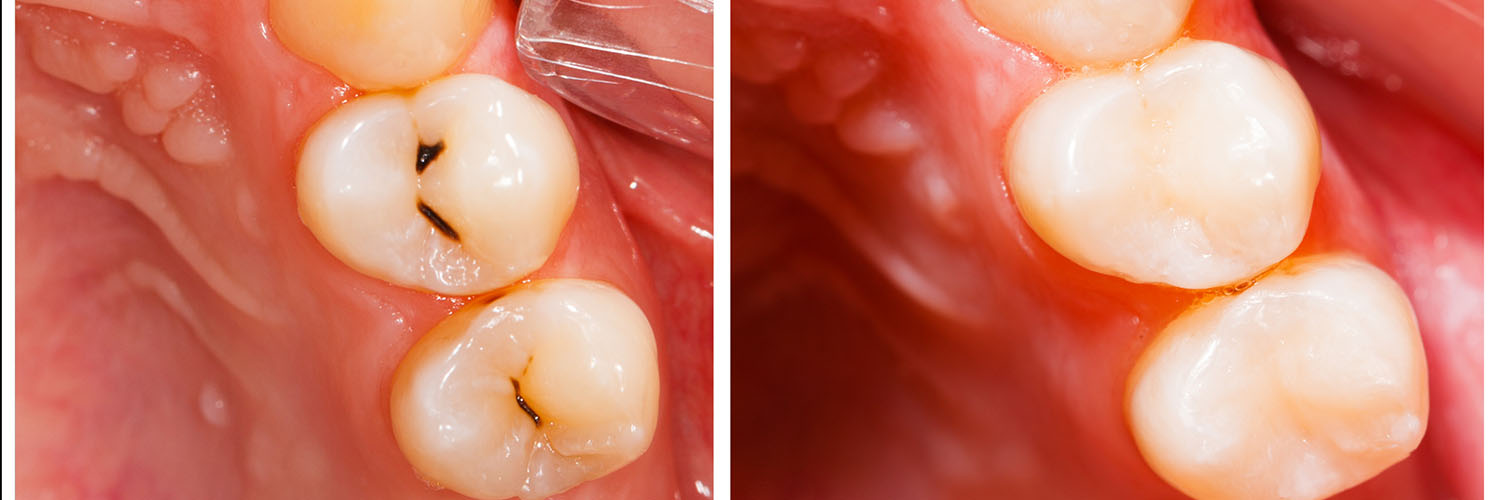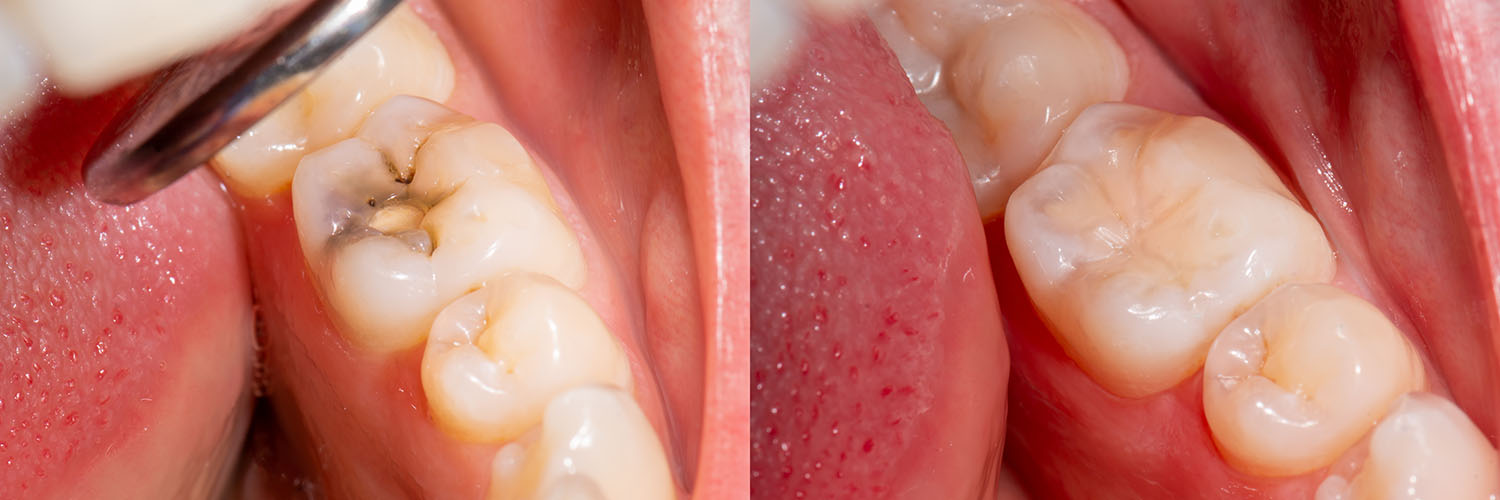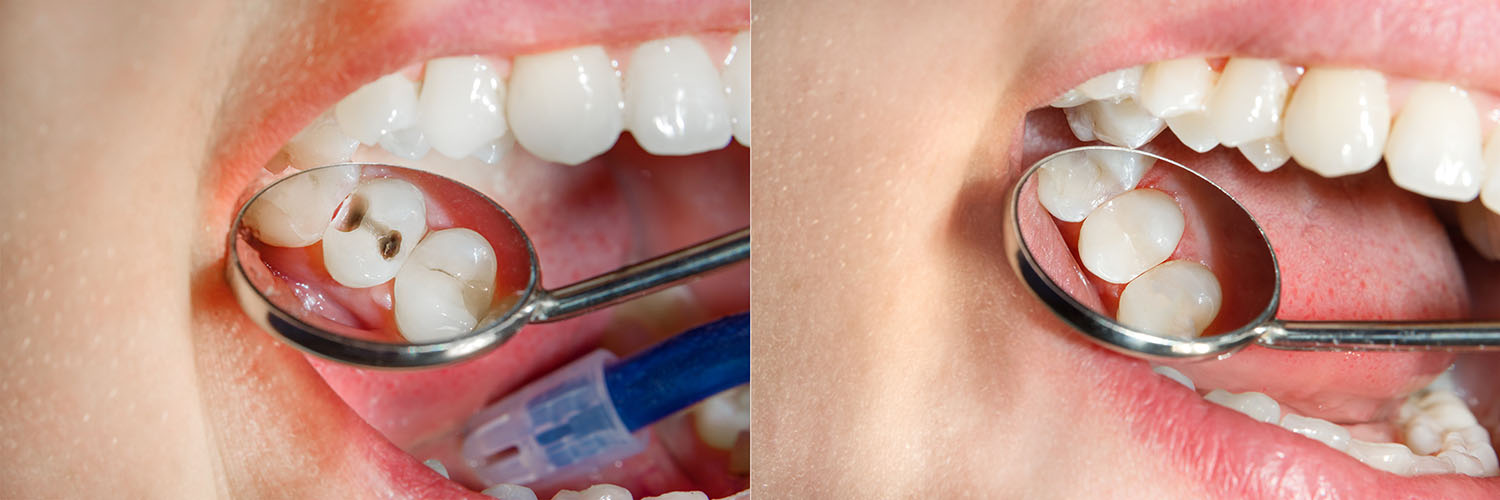
When a cavity undermines a tooth’s strength, a thoughtfully placed filling restores its shape and lets you chew, speak, and smile with confidence again. Modern restorations are designed not only to replace lost structure but also to integrate with the remaining tooth so the finished result performs reliably for years.
Tooth decay is a common health issue across all ages, and fillings remain one of the most frequent procedures performed in dental practices. Despite that familiarity, today’s techniques and materials offer better aesthetics and less invasive preparation than earlier generations of restorations, so patients benefit from care that looks natural and preserves more healthy tooth tissue.
At Suss Dental Group, our approach emphasizes precision and patient comfort. We assess each situation individually, explain your material choices, and use techniques that minimize discomfort while maximizing long-term outcomes.
Humans have attempted to repair teeth for millennia, and the materials and methods have evolved considerably. Early attempts are visible in archeological records, while the 19th and 20th centuries introduced metals such as gold and amalgam that improved durability and accessibility.
Over the past several decades, however, dentistry has moved toward materials that provide a natural appearance and are kinder to remaining tooth structure. Resin composites, glass ionomers, high-strength ceramics, and precision-fitted indirect restorations now give clinicians the flexibility to tailor treatment to both functional and cosmetic goals.
Understanding this history helps explain why dentists today choose from multiple options: each material has trade-offs, and the best choice depends on the tooth’s location, the size of the defect, and your personal priorities for appearance and longevity.
Selecting a filling is rarely a one-size-fits-all decision. We begin with a thorough exam and diagnostic images when needed, then discuss the advantages and limitations of the appropriate materials so you can make an informed choice. Our priority is to restore health and function while preserving as much natural tooth as possible.
Factors that guide material selection include how much tooth structure remains, the forces that tooth will need to endure, visibility when you smile, and whether you have a history of sensitivity or wear. We explain each recommendation in plain language and show how different options will affect the appearance and durability of the restoration.
For patients who prefer minimal intervention, we offer conservative techniques that bond restorations to the tooth and require less removal of healthy structure. If durability or heavy chewing forces are the key concern, we can discuss alternatives that offer increased strength while still maintaining a natural look.

Today’s restorative toolkit gives dentists several reliable choices for filling a cavity. Each material performs differently in terms of strength, wear resistance, appearance, and how much tooth preparation it requires. Below is an overview of commonly used options and the scenarios where they tend to work best.
We focus on materials that balance function and aesthetics, and we place restorations with careful attention to fit and bite so the repaired tooth functions comfortably alongside your natural dentition.
Composite fillings are made from a blend of polymer resin and fine glass or ceramic fillers. They are available in a spectrum of shades, so a skilled clinician can match them to the surrounding enamel for a seamless appearance. Composite restorations bond to the tooth structure and can even strengthen thin tooth walls through adhesive techniques.
Compared with older metal restorations, composites often require removing less healthy tooth tissue and avoid the metallic appearance of amalgam. They are versatile and widely used for front and back teeth when a natural look matters. Like all materials, they can show wear over many years and may need repair or replacement depending on function and oral habits.
Amalgam (silver-colored) fillings have a long track record for durability and are a robust option for teeth that endure high chewing forces. While they do not offer a tooth-like appearance, their strength and longevity have made them a dependable choice for certain posterior restorations.
When longevity in high-stress areas is the primary concern, amalgam remains a technically sound option. Our team discusses aesthetic alternatives when patients prefer a less conspicuous restoration.
Glass ionomer materials chemically bond to tooth structure and release small amounts of fluoride over time, which can help protect the surrounding enamel. They are particularly useful for shallow cavities near the gumline, pediatric restorations, or temporary repairs.
Although not as wear-resistant as composites or ceramics, glass ionomers are valuable when a gentle bond and fluoride release are beneficial. They offer a practical balance between protection and minimal preparation in specific clinical situations.
When a cavity is too large for a direct filling but a full crown is not required, an indirect restoration such as an inlay or onlay fabricated from porcelain or ceramic can be an excellent solution. These are made outside the mouth and precisely cemented into place, providing exceptional fit and wear resistance.
Ceramic restorations are highly stain-resistant and mimic the translucency of natural teeth, making them a strong choice where aesthetics and durability are both priorities.
Gold remains one of the most durable and biocompatible restorative metals. While used less frequently today because of its cost and visibility, gold offers excellent longevity and a gentle interaction with opposing teeth.
In select situations where strength and long-term stability are paramount, gold inlays or onlays continue to be a viable, well-proven option.

When a filling is recommended, the appointment follows a straightforward sequence focused on comfort and efficiency. We start with a clinical exam, review any X-rays if needed, and explain the chosen restoration and the steps we’ll take to protect adjacent teeth and soft tissues.
Local anesthesia is commonly used to ensure a painless experience; once the area is numb, the dentist will remove decayed tissue and shape the remaining tooth to receive the restoration. Depending on the material, the filling may be placed directly and finished in one visit, or an indirect restoration may require a short series of appointments.
Using contemporary bonding techniques and precise bite adjustment, we polish and refine the restoration so it feels comfortable within your bite. Most straightforward fillings are completed in about an hour, though larger or complex restorations may take longer.
If dental anxiety is a concern, our team offers a calm, supportive environment and can discuss options to make your visit more comfortable. We tailor our care to meet individual needs and ensure you understand each step before we begin.
A successful filling is followed by simple aftercare that helps the restoration last. Good oral hygiene—regular brushing with fluoride toothpaste, daily flossing, and routine dental checkups—keeps the margins of the filling clean and reduces the risk of recurrent decay.
Immediately after treatment: It’s common to experience temporary numbness from local anesthesia. Avoid chewing or sipping hot beverages until sensation returns to prevent accidental injury to lips, tongue, or cheek.
Expect transient sensitivity
The treated tooth may be sensitive to temperature changes or biting pressure for a few days. This usually resolves as the tooth settles; if sensitivity persists or worsens, contact our office for an assessment.
Bite feel and final adjustments
Although we carefully adjust your bite before you leave, you may notice minor high spots after the anesthetic wears off. If your bite feels uneven, we can make a quick, painless adjustment to improve comfort.
Longevity depends on care
With proper hygiene and routine professional maintenance, most restorations perform well for many years. Habits like grinding, biting hard objects, or uneven chewing forces can shorten a filling’s lifespan and may require future repair.
We’re committed to clear communication and compassionate care. If you have any questions about a recent filling or notice unusual symptoms, please contact our practice so we can address your concerns promptly.

In summary, modern fillings combine materials science and conservative techniques to restore health, function, and appearance. Whether you need a small composite repair or a more durable indirect restoration, our team at Suss Dental Group focuses on solutions that preserve tooth structure and support long-term oral wellness. Contact us to learn more about which option is right for your smile.

If the pleasure of eating a delicious bowl of ice cream or sipping a soothing cup of tea gets overshadowed by dental pain that makes you wince; it's time to contact our office. As skilled providers of care, we'll determine what's causing your discomfort and perform the treatment required to alleviate your symptoms and get you back on the road to oral health.
Cavities develop because of an infectious process that causes progressive damage to tooth structure. Despite starting as a pinpoint defect on the outermost enamel layer of your tooth, untreated dental decay progressively compromises more and more healthy tooth structure as it works its way to the inner layers of your tooth.
Yes, you can still develop tooth decay on other surfaces of the tooth, around the margins of an old filling, or in fewer instances, recurrent decay underneath it. For this reason, it's essential to maintain excellent oral hygiene, a diet low in sugary beverages and sweets, and be sure to visit our office for routine checkups and care. While tooth decay is second only to the common cold in frequency, it's almost entirely preventable.
We value the time and comfort of our patients. If cavities are located on adjacent teeth, or in the same section of your smile, it may be possible to treat more than one tooth during your visit. However, how much is done each visit depends on several factors. We keep our patients well informed and tailor every treatment plan and visit to address their unique needs.
Addressing concerns on the presence of elemental mercury in silver fillings, the American Dental Association (ADA), The Center for Disease Control and Prevention (CDC), the FDA, and the World Health Organization have all stated that amalgam restorations do not pose a risk to health. However, individuals with allergies or sensitivities to the metals in dental amalgam are advised to pursue other restorative options.
Dental fillings are performed under local anesthesia to help ensure your comfort throughout the entire procedure. The involved tooth remains completely numb for the extent of your visit. Within one or two hours after the procedure is completed, the local anesthetic will gradually wear off, and normal sensations return.
A tooth-colored composite filling is fully hardened and set by the end of your visit. However, we may advise you to wait a couple of hours until the local anesthesia has completely worn off. This advice is to help ensure you don't accidentally bite your lip, cheek, or tongue while still numb.
The lifetime of a dental filling varies depending on the type of material used. While popular dental materials can last a decade or more with proper care, they can degrade over time, wear down, or even break. When this happens, you may experience some tooth sensitivity, a jagged edge, or a loose or dislodged piece of filling material. Whatever the case may be, it's essential to get the filling replaced before the tooth sustains further damage or other consequences arise. Beyond taking good care of your smile to help ensure the longevity of your fillings, our office regularly checks the status of your existing fillings as part of a routine checkup exam.
Dental fillings are an essential investment that serves to preserve and protect the health of your smile. With that said, how much a filling costs depends on the number of surfaces of the tooth involved and the filling material that is used. Amalgam restorations are the most economical. While tooth-colored composite fillings have a slightly higher cost, they offer the added benefits of being metal-free and much more aesthetically pleasing. Ceramic fillings, inlays, and onlays are more expensive than the preceding options but provide outstanding, long-lasting, and natural-looking results.
Dental insurances typically cover the cost of dental fillings. While we work with you to maximize your insurance benefits, there may still be an out-of-pocket expense. At the office of Suss Dental Group, we strive to help you begin care without any additional financial stress or delay.
Dental fillings are restorations placed to repair teeth damaged by decay or minor fractures so the tooth can regain normal form and function. They replace lost tooth structure, seal the area against further bacterial invasion, and help restore comfortable chewing and speaking. Modern filling techniques aim to preserve as much healthy tooth as possible while providing a durable surface that integrates with surrounding enamel.
Fillings can be placed in a single visit for most cavities, and the choice of material influences how the restoration looks and performs. Advances in adhesive dentistry and restorative materials have reduced the amount of tooth removal required and improved long-term outcomes. Discussing the role of a filling early helps prevent more extensive treatment later.
Common filling materials include tooth-colored composite resins, glass ionomer cements, traditional amalgam, and indirect ceramic or gold restorations such as inlays and onlays. Composites are favored for their aesthetic match and adhesive properties, glass ionomers release fluoride and bond chemically to tooth structure, and amalgam has a long history of durability for high-stress posterior teeth. Indirect ceramic or gold restorations are fabricated outside the mouth when a larger portion of the tooth needs replacement and offer exceptional fit and wear resistance.
Each material offers trade-offs in terms of strength, wear resistance, appearance, and how much tooth preparation is required. Your dentist will recommend options based on the location of the tooth, the size of the defect, and functional demands. Understanding these differences helps patients choose a restoration that balances appearance, longevity, and preservation of healthy tooth tissue.
Selection of a filling material is an individualized process that considers how much tooth structure remains, the forces the tooth must withstand, its visibility when you smile, and any history of sensitivity or bruxism. Small, visible cavities often lend themselves to tooth-colored composites, while larger posterior restorations may require indirect ceramic onlays or other high-strength solutions. The dentist will also evaluate oral hygiene, opposing teeth, and the patient’s priorities for appearance and durability.
Diagnostic imaging and a careful clinical exam guide this decision, and your dentist should explain the advantages and limitations of the recommended materials in plain language. When possible, conservative bonding techniques are used to preserve enamel and dentin and avoid unnecessary tooth reduction. Shared decision-making ensures the chosen restoration aligns with both functional needs and cosmetic expectations.
A typical filling appointment begins with an exam and any necessary X-rays, followed by local anesthesia to ensure a comfortable, pain-free procedure. The dentist removes decayed or compromised tissue and shapes the remaining tooth to receive the restoration using techniques tailored to the chosen material. For direct restorations like composites, the filling is placed, shaped, and polished in one visit; for indirect restorations such as inlays or onlays, impressions or digital scans are taken and the final piece is cemented at a subsequent appointment.
Throughout the procedure the team protects adjacent teeth and soft tissues and checks the bite to ensure proper function when you leave. Most straightforward fillings take about an hour, though treatment time varies with size and complexity. If dental anxiety is a concern, discuss comfort measures with the team before the appointment.
Most patients experience little to no pain during a modern filling because local anesthetic is used to numb the area being treated. The injection itself may cause brief pressure or mild discomfort, but techniques such as topical anesthetic and slow administration minimize these sensations. Once numb, removal of decay and placement of the restoration are typically comfortable, and the clinician checks frequently to ensure the patient remains at ease.
After the anesthetic wears off you may notice transient soreness or sensitivity to temperature and pressure for a few days, which normally subsides as the tooth adjusts. If discomfort is prolonged or intensifies, contact the dental office for an evaluation to rule out issues such as high bite contacts or underlying infection. The care team can recommend gentle pain control measures and follow-up as needed.
Good oral hygiene is the foundation for protecting a new filling: brush twice daily with fluoride toothpaste, floss daily, and maintain routine dental checkups and professional cleanings. Avoid chewing very hard objects and be mindful of habits such as nail-biting or using teeth as tools, which can stress restorations. If you clench or grind your teeth, discuss protective options such as a nightguard to reduce wear and extend the life of fillings.
Pay attention to changes in sensation around the filled tooth, such as persistent sensitivity, a rough or high spot when you bite, or signs of recurrent decay at the margin. Early evaluation allows minor repairs that can prevent more extensive treatment later. Keep a record of when restorations are placed so your dentist can monitor wear patterns during routine exams.
The lifespan of a filling varies widely depending on the material, the location of the tooth, oral habits, and the patient’s oral hygiene. Composite fillings commonly last many years but may wear or discolor sooner in high-stress areas, while amalgam and well-made ceramic restorations can endure for a decade or longer under favorable conditions. Factors that shorten longevity include heavy chewing forces, grinding, biting hard objects, and recurrent decay at the restoration margins.
Regular dental examinations allow the clinician to detect early signs of wear, leakage, or secondary decay so timely maintenance or replacement can be performed. When a restoration shows signs of failure, addressing it promptly helps preserve remaining tooth structure and reduces the need for more extensive treatments such as crowns. Maintaining a partnership with your dental team supports predictable, long-term outcomes.
Tooth-colored composite resins and ceramic restorations are designed to match the shade and translucency of natural enamel, allowing skilled clinicians to create seamless results in both front and back teeth. Composites are available in a range of shades and can be layered to mimic natural optical properties, while ceramics offer superior stain resistance and long-term color stability. The final appearance depends on proper material selection, shade matching, and careful finishing and polishing.
Composites can stain over time from foods and beverages, though good oral hygiene and periodic professional polishing help maintain appearance. Ceramic inlays and onlays are highly resistant to staining and retain their translucency, making them a strong aesthetic option when durability and color stability are priorities. Your dentist will discuss which choice best meets your cosmetic goals and functional needs.
When a cavity is too extensive for a direct filling to provide predictable strength or when existing tooth structure is compromised, an indirect restoration such as an inlay, onlay, or crown may be recommended. Inlays and onlays restore larger defects while preserving more natural tooth than a full crown, and they are fabricated outside the mouth from durable materials like porcelain or gold. Crowns cover the entire visible portion of the tooth and are used when structural support or full-coverage protection is required.
Indirect restorations offer precise fit, superior wear resistance, and enhanced longevity for teeth under heavy occlusal load. The dentist evaluates the extent of decay, remaining tooth walls, and future functional demands to determine whether a direct filling or an indirect approach will best preserve the tooth. This decision balances conservation of tooth tissue with long-term predictability and appearance.
At Suss Dental Group the emphasis is on conservative, evidence-based techniques that preserve healthy tooth structure while restoring function and appearance. Clinicians prioritize adhesive approaches and minimally invasive preparations when appropriate, and they discuss the pros and cons of each material so patients can make informed choices aligned with their priorities. The care team also incorporates modern anesthetic and behavioral techniques to minimize discomfort and anxiety during treatment.
Follow-up and ongoing preventive care are part of the practice’s philosophy to protect restorations and maintain oral health over time. During routine visits the team monitors restorations for wear or breakdown and recommends timely maintenance to avoid more extensive treatment. Patients are encouraged to ask questions so the plan of care reflects both clinical needs and individual comfort preferences.

Ready to schedule your next dental appointment or have questions about our services?
Contacting Suss Dental Group is easy! Our friendly staff is available to assist you with scheduling appointments, answering inquiries about treatment options, and addressing any concerns you may have. Whether you prefer to give us a call, send us an email, or fill out our convenient online contact form, we're here to help. Don't wait to take the first step towards achieving the smile of your dreams – reach out to us today and discover the difference personalized dental care can make.